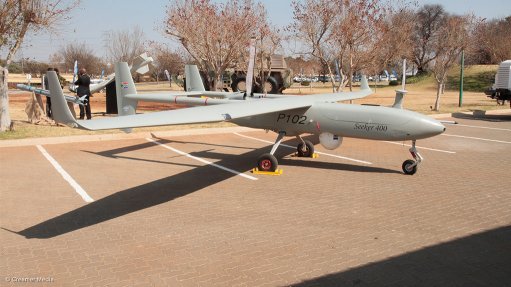
Photo by: Duane Daws
No fewer than three of the development projects being carried out by local missile, unmanned aerial vehicles (UAVs) and satellite company Denel Dynamics (part of the State-owned Denel group) are coming to an end and being transformed into industrialisation and production programmes for local and foreign customers. They are the A-Darter missile, the Seeker 400 UAV and the Umbani precision guided bomb kit. “We are really proud of our achievements in these programmes,” highlights company CEO Tsepo Monaheng. “Now we are in a position to release critical engineers and other resources to work on new development programmes.”
The A-Darter is an infrared homing air-to-air missile, conceived by Denel Dynamics but jointly developed with Brazil. Development of the missile has now reached completion, and it is expected that the first contract for industrialisation and production of the weapon will be signed later this month or next month. There will be two such contracts, one for each of the two partner countries. The second such contract will be signed later this year. There will be production lines in both countries. “We will start to establish the production line here in April,” he states. “We’ll also be assisting our Brazilian partners to establish a production line there.” Recently, at his farewell function, the outgoing Brazilian Air Force attaché to South Africa highly praised the A-Darter’s performance and Denel Dynamics’s cooperation with his country.
Already, another country is seriously interested in acquiring the A-Darter. If a contract is signed, the missiles would be assembled on the South African production line. “The potential for more customers is now considerable, because we now have a product, not just a programme,” points out Denel Dynamics deputy CEO Denise Wilson. “We’ll be ramping up to produce five A-Darters a month, on the South African production line. We’ll source most components from local industry and so create local jobs.”
The third and final development guided test series was recently completed. This proved the performance of the missile. “It has exceeded expectations!” she reports. “Now we’re finishing the qualification of the missile. The final qualification flight tests are planned for later this year. “The missile will fly whatever mission is specified by the client. We now have the latest state-of-the-art processors on the missile.”
The Seeker 400 is actually more advanced than the A-Darter, because it is already in production for its launch customer, an overseas client. “The Seeker 400 has just been through a range of performance evaluation tests, including range and altitude and it performed very well against specifications,” notes Wilson.
“We have one customer for the Seeker 400 now, but we’re talking to four other potential customers,” points out Monaheng. “One of these witnessed the recent successful demonstration of the Seeker 400.” In addition to the Seeker 400, a large tactical UAV (with the potential to be armed), the company also offers the Seeker 200 tactical UAV and the Hungwe small UAV. Once, the South African Air Force was a leader in UAV operations, but it has not operated any UAVs for many years now. “We’re hoping that UAVs are going to be re-introduced into the air force later this year,” he says.
As these projects become production programmes, new development projects are taking their place. A major new project is the Marlin. This will be a beyond-visual-range radar homing missile, with more than one role. “The Marlin is in the technology demonstration phase. It is being funded by the Department of Defence. “We have the funding for the technology demonstration,” says Wilson. “It is intended for air-to-air, ground-to-air and naval surface-to-air roles. Its rocket motor has already been tested. “Certain preliminary tests of the airframe will take place during this year.” Although intended to fulfill the requirements of the South African National Defence Force, it has already attracted overseas interest.
“It’s a really interesting technology programme,” she cites. “It’s giving the opportunity for young engineers to grow with the programme. “It’s delivering a new generation of engineers. “Ideally, you want people to be with this programme for the next 15 to 20 years,” adds Monaheng.